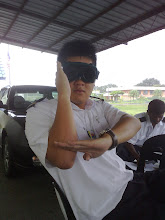.jpg)

.jpg)
.jpg)
Greetings ...
Anyone of u watch F1 racing ? Some of my friend asked Why silver Mercedes Benz with yellow flashing lights deploy during the race .Well it simple for a dramatic expression of the relative performance of Formula One cars and road cars you need to look no further than the familiar, silver forms of the safety car that features at every Grand Prix.
The safety car is very important to ensuring the spectacle of a Formula One race does not suffer from undue disruption, as its use allows the race to continue even after a major accident, or other incident serious enough to require the presence of marshals on the track. This obviously cannot be allowed to happen with cars running at full speed - or even under the caution of yellow flags (as a driver may fail to observe them). Instead the safety car is deployed and the pack 'forms up' behind it - running in formation - until the obstacle or other problem has been cleared away.
It sounds easy. Yet even some of the very fastest road cars in the world, driven flat-out, are barely capable of maintaining a comfortable pace for Formula One cars (which lose tyre temperature and can even suffer from engine overheating during slow running). Since 1996 Mercedes-Benz has supplied Formula One safety cars to all rounds of the FIA Formula One World Championship, and the 2009 model is an SL 63 AMG. It has been modified to reduce its weight and improve braking response - but even with 386 kW (525 bhp) output from its V8 engine, that's still only around two-thirds of the power of a current Formula One car (combined with around three times the mass.)
Hence the very real importance of the man in the driving seat. Bernd Maylander is an experienced racer who has driven in the tough German Touring Car (DTM) championship, and who has been charged with the responsibility of piloting the Formula One safety car since 2000. His experience and ability to drive up to the car's high limits ensure that - although lap times increase dramatically during safety car running - speeds are still high enough to allow the race cars to function correctly.
As with the medical response car, the safety car is on standby throughout a Grand Prix, ready to be dispatched by Race Control at a moment's notice. State-of-the-art radio and video equipment enable communication to be maintained at all times. When the Race Director decides to deploy the safety car it will join the track immediately and from that point no car may enter the pitlane and no overtaking is allowed. The safety car will then allow cars to pass it until the race leader is immediately behind it. When signalled to do so, any lapped cars in among the leading pack may then unlap themselves, pass the safety car and proceed around the circuit to retake their positions at the back of the field. Once the correct race order has been restored, the pitlane will reopen. Throughout the process, a 'Safety Car' board is also displayed to drivers as they cross the start-finish line, and the information will also be relayed over radios from the pitlane.
When the Race Director orders the safety car to leave the track again, a similarly exact procedure is followed. At the start of its final lap the safety car will turn off its orange flashing lights. Competitors must still remain behind in formation, but they know that at the beginning of the next lap they will be racing again. The safety car will pull off into the pits at the end of the lap and - as they cross the line - the competitors restart their battle.
Monday, April 13, 2009
Formula 1 safety car ..
Posted by Lucas Lee at 4/13/2009 01:39:00 PM
Subscribe to:
Post Comments (Atom)

0 comments:
Post a Comment